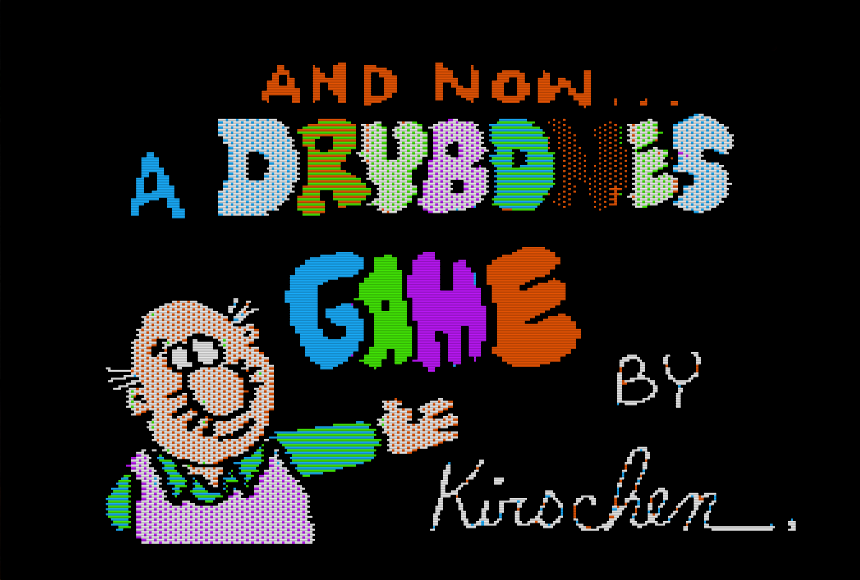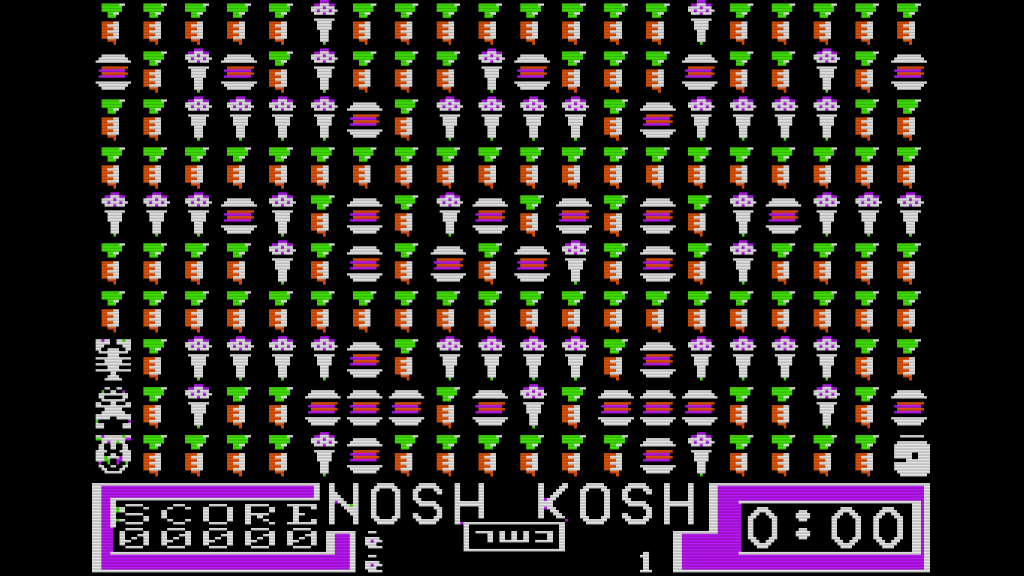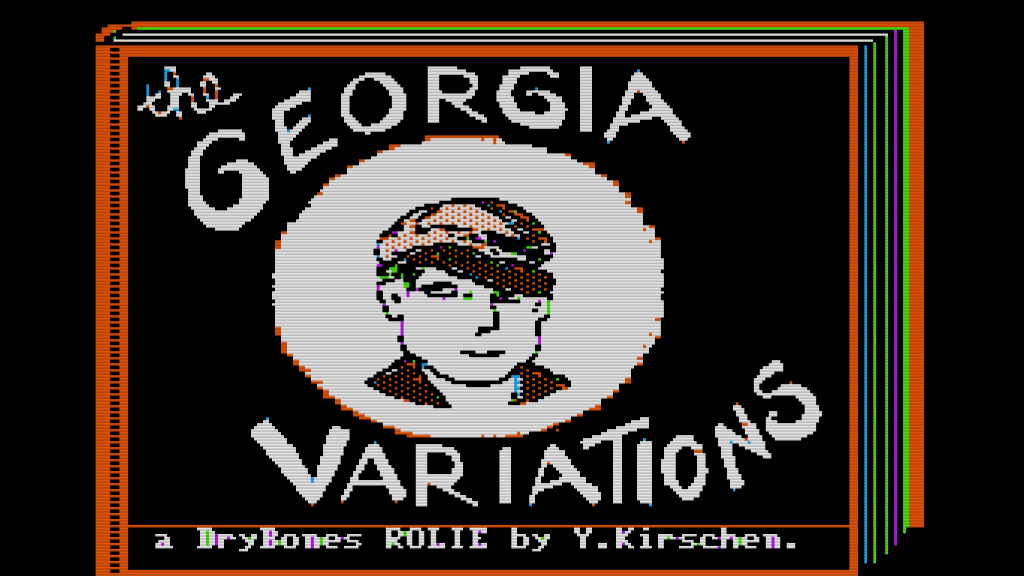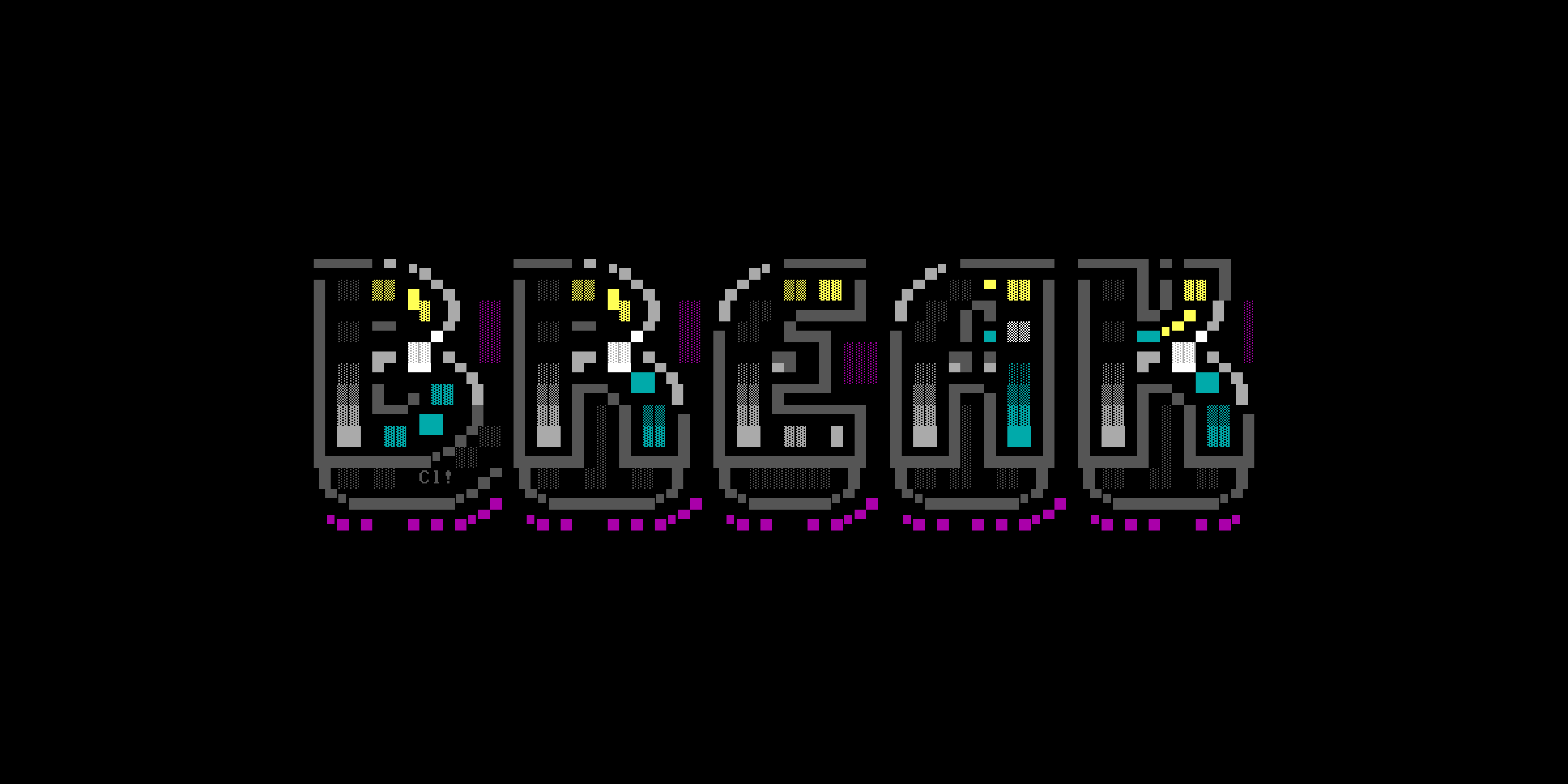
Ever wonder what the Jewish version of Pac-Man might look like?
In the early 1980s, video games were exploding in popularity with kids and microcomputers were becoming available Israel. The Gesher organization saw potential in developing educational software specifically for Jewish students. From 1982 to 1984, Yaakov Kirschen worked with them on four games:
- “Aleph Baiters” (1983)
- “Nosh Kosh” (1983)
- “Borders” (1983)
- “The Georgia Variations” (1984)
Keep reading for more background on Gesher and Kirschen, as well as details about each of the games.
This is the first of five sets of curated disk images containing previously lost software developed by Kirschen. Stay tuned for more.
This software was rescued from 5.25″ floppy disks, sent to Josh Renaud by Sali Ariel, Kirschen’s wife. The disks were imaged by Keith Hacke in 2020, then curated by Renaud.
Do you enjoy my retrocomputing stories on Break Into Chat? Please join my email list and stay in touch. 📬
Background
Rabbi Daniel Tropper founded Gesher, which means “bridge” in Hebrew, in 1969. He aimed to connect secular and religious Israeli kids, to get them to talk and learn from each other at informal seminars.
By the early 1980s, Gesher had grown significantly. They were developing curricula and educational materials for schools, and looking for ways to use new media to reach kids, including television programs.
Video games had exploded in popularity by this time, but the idea of using them for education, particularly Jewish education, remained controversial. So perhaps it’s not surprising that video games weren’t immediately on Gesher’s radar.
Instead, they were working on board games, among other things. Nissan Zisken, one of Gesher’s early group leaders, was tasked with developing a game to help kids learn about Jewish identity. In preparation, he spoke with educational philosophers and historians to develop material for the game.
But everything changed when Tropper told a friend in Cleveland about the board game. Samuel W. Spero, a professor of mathematics and computer science at Cuyahoga Community College, had been an early adopter of using mini- and microcomputers in classrooms. When he heard about Zisken’s board game, he suggested to Tropper that Gesher should make an adventure computer game instead.
Tropper was enamored with the idea and saw an opportunity for Gesher. He set up a new department to develop educational computer games and put Zisken in charge.
Zisken’s team planned to create one or two “big” games that would explore Jewish identity through history, and possibly make use of advanced technology like Pioneer’s videodisc. They intended simultaneously to create two or three “small” games, each based on an existing arcade game, that would teach a particular educational concept.
By spring of 1982, Gesher had assembled a software team of about 10 people, including programmers and historians. The team’s first finished game was likely “Jerusalem Squares,” a Jewish history quiz game patterned on the “Hollywood Squares” television program. It had a modular design so that disks with different question banks could be swapped in and out. As of November 2022, I have not located any copies of “Jerusalem Squares.”
“Jerusalem Squares” probably used a text-only interface — Gesher’s software team had little experience with graphics or animation. So in late 1982, they hired Jerusalem Post cartoonist Yaakov Kirschen, who was well known in Israel and across the Jewish diaspora, for his cartoon “Dry Bones.” Kirschen was an accomplished artist, and had previously experimented with making rudimentary animated versions of his cartoons for several Israeli TV news programs.
Months later, in early 1983, Zisken left Gesher — apparently supplanted by Kirschen. After that, Kirschen effectively became the “creative director” for the team. Under his direction, Gesher completed four more games for the Apple II, which are the ones included in this archive.
Three of those, “Aleph Baiters,” “Nosh Kosh,” and “Borders” were examples of the “small” arcade-style games that the team had envisioned. The fourth, “The Georgia Variations,” was a larger role-playing game. It probably drew on the research and planning for “Roots and Routes,” one of the planned “big” games which never materialized as originally envisioned.
All four games were shown at the Council of Jewish Federations’ General Assembly in Atlanta, Ga., in November 1983. The games apparently never were sold or distributed commercially, except in 1987, when the Carolina Agency for Jewish Education of Charlotte, N.C., obtained permission to sell three of the games at cost to Jewish educational groups in the U.S. They charged $3 for “Nosh Kosh” or “Borders,” and $8 for “The Georgia Variations” (which came on five floppy disks).
I have located this software in only one other place — the Breman Museum apparently holds a floppy disk of two in-progress demos (“Borders” and “Nosh Kosh”) sent by Gesher to Jane Leavey of the Atlanta Jewish Federation to show her what they were developing for the 1983 general assembly.
The software
ALEPH BAITERS

The action in this game is loosely based on Space Invaders. The concept was to teach children to recognize the characters of the Hebrew alphabet. Players control a hand and use it to select the correct letter from descending rows of letters.
Disk images:
UPDATE (Jan. 15, 2023): I replaced the original .DSK file with a .WOZ prepared by John Keoni Morris, after I learned that the .DSK did not work in MAME and many other emulators because of a quirk in the disk’s volume number (though it did work in MicroM8).
Credits shown in the game:
(c) 1983, Gesher Educational Affiliates
Programming by:
Meir Komar
Yair Yehuda
Yechiel Fridman
Game design and graphics by:
Dry Bones
Note: The “ALPHA.16” BASIC file contains comments dated 1982-12-01. The “ALPHA.23” BASIC file contains comments dated 1983-07-22.
NOSH KOSH

The action in this game is based on Pac-Man. The concept was to teach children about kashrut, Jewish dietary law. Players move a character around the screen and can eat one of three types of food: ice cream, meat, or carrots. But if the player eats meat, he must wait 6 hours before eating an ice cream. The player also must avoid a lobster enemy.
Disk images:
Credits shown in the game:
(c) 1983, Gesher Educational Affiliates
A Dry Bones game by Kirschen
Systems design:
Danny Wiseburgh
Applications programming:
Chani Shidlovsky
Note: An apparently deprecated BASIC file (“TITLE”) has code for a scrolling text title. The credits given here are:
Programming: Chani Shidlovsky
Technical advisor and special effects: Danny Wiseburgh
Music: Yechiel Fridman
Game design and graphics: Dry Bones
BORDERS

The action in this game is loosely based on Donkey Kong. Each “platform” in the game represents a different historical era during which Jews faced persecution. The player is chased by period-appropriate enemies on each platform. To progress, the player must jump and touch a Torah icon, which will unlock an elevator. Then the player must avoid the enemies and reach the elevator, which will lift him to the next platform/time period. If a player successfully completes all the stages, he can see an animated final sequence.
Disk images:
Credits shown in the game:
(c) 1983, Gesher Educational Affiliates
A Dry Bones game by Kirschen
Programming by:
Yechiel Fridman
Systems design by:
Danny Wiseburgh
THE GEORGIA VARIATIONS

This is a choice-based narrative game where you play the role of Boris Goldberg, a Jewish boy in Eastern Europe in the late 19th century. The player makes choices throughout the game which affect the storyline, but all threads eventually lead to the same ending: Goldberg immigrates to Atlanta, Georgia.
In 1982, members of the Atlanta Jewish Federation began preparing for the 250th anniversary of Jewish settlement in Georgia which would take place the next year. They worked out a contract for Gesher to develop games for them dealing with Georgia Jewish history. “The Georgia Variations” was the end product, and Kirschen debuted it in an interactive history exhibit at the Council of Jewish Federations’ General Assembly in November 1983.
Kirschen described the game as the world’s first “roli” (or “rolie”), and variously explained the term as an acronym for “robotic literature”; or as a “conversation that you have a role in.” Kirschen, who tended to be hyperbolic when promoting his work, described the game as a groundbreaking achievement in interviews. He seems not to have been familiar with similar, but more advanced, games produced by Infocom, Sierra Games, and others.
Disk images:
- georgia-1.dsk (Disk 1)
- georgia-a.dsk (Disk A)
- georgia-b.dsk (Disk B)
- georgia-c.dsk (Disk C)
- georgia-t.dsk (Disk T)
Note: This game consists of five disks: 1, A, B, C, and T. Disk 1 is the disk you start with. The game will prompt you to insert other disks as you move through the story.
Credits shown in the game:
(c) 1984, Gesher Foundation
A Dry Bones rolie by Kirschen
Historical and pictorial research by:
Dr. David Geffen
Music by Yechiel Fridman

Share your thoughts!